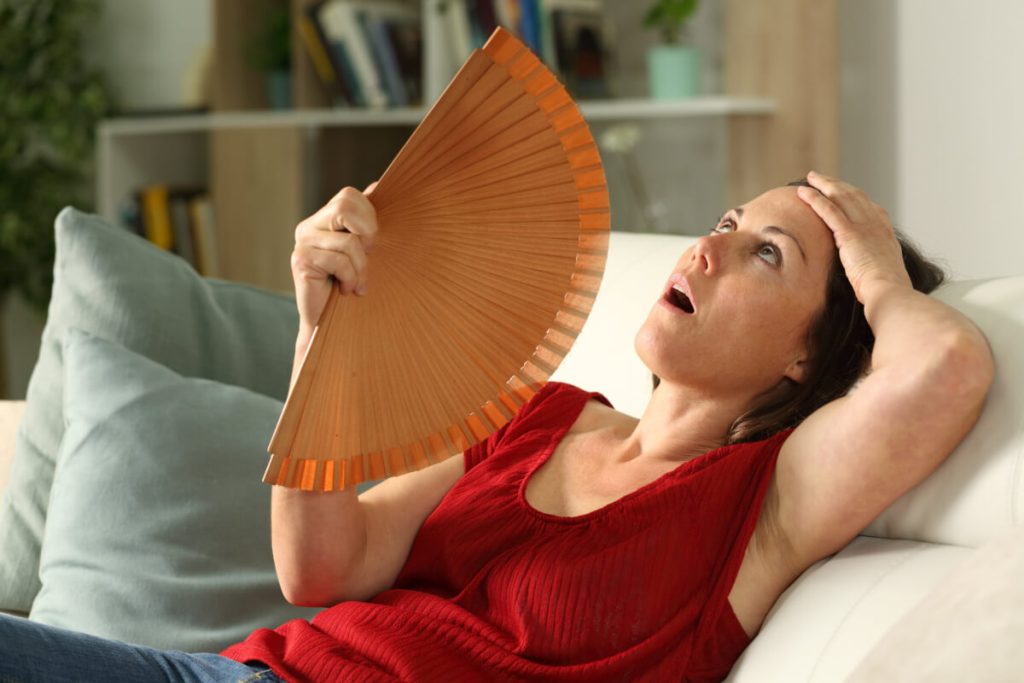

A woman experiencing hot flashes due to menopause (Photo by Pheelings media on Shutterstock)
In a nutshell
- More than half of women ages 30-35 already experience moderate to severe perimenopause symptoms, though most don’t seek treatment until their 50s.
- Psychological symptoms like anxiety and depression appear earlier in perimenopause (peaking at ages 41-45), while physical symptoms like hot flashes and vaginal dryness peak later (ages 51-55).
- Eight key symptoms are strongly associated with perimenopause: menstrual irregularities, hot flashes, vaginal dryness, painful intercourse, heart palpitations, and frequent urination.
CHARLOTTESVILLE, Va. — Perimenopause—the transitional phase leading up to menopause—has long been considered a mid-life experience, typically affecting women in their late 40s. However, new research reveals that a significant number of women in their 30s are already experiencing perimenopausal symptoms severe enough to seek medical attention.
In a survey of 4,432 U.S. women, researchers from Flo Health and the University of Virginia found that more than half of those in the 30-35 age bracket reported moderate to severe menopause symptoms using the validated Menopause Rating Scale (MRS). Among those who consulted medical professionals about their symptoms, a quarter were diagnosed as perimenopausal. This challenges the assumption that perimenopause is primarily a concern for women approaching 50.
The findings, published in the journal npj Women’s Health, highlight a significant gap in healthcare awareness and support for women experiencing early-onset perimenopause.
Unrecognized Symptoms and Healthcare Gaps
“Physical and emotional symptoms associated with perimenopause are understudied and often dismissed by physicians. This research is important in order to more fully understand how common these symptoms are, their impact on women, and to raise awareness amongst physicians as well as the general public,” says study co-author Dr. Jennifer Payne, MD, an expert in reproductive psychiatry at UVA Health and the University of Virginia School of Medicine, in a statement.
Despite medical definitions being well established, public understanding remains muddled. Many people use “menopause” as a catch-all term for both perimenopause and post-menopause. This confusion contributes to women feeling unprepared and unsupported during this transition.
The journey through perimenopause varies. Some women experience a smooth 5-7 year transition with manageable symptoms, while others face a decade-long struggle with physical and psychological challenges that impact daily life.


Early vs. Late Perimenopause
“Perimenopause can be broadly split into early and late stages,” the researchers explained. Early perimenopause typically involves occasional missed periods or cycle irregularity, while late perimenopause features greater menstrual irregularity with longer periods without menstruation, ranging from 60 days to one year.
The study identified eight symptoms significantly associated with perimenopause:
- Absence of periods for 12 months or 60 days
- Hot flashes
- Vaginal dryness
- Pain during sexual intercourse
- Recent cycle length irregularity
- Heart palpitations
- Frequent urination
While symptom severity generally increased with age, women in their 30s and early 40s still experienced significant symptom burden. Among 30-35-year-olds, 55.4% reported moderate or severe symptoms, increasing to 64.3% in women aged 36-40.
“We had a significant number of women who are typically thought to be too young for perimenopause tell us that they have high levels of perimenopause-related symptoms,” said Liudmila Zhaunova, PhD, director of science at Flo. “It’s important that we keep doing research to understand better what is happening with these women so that they can get the care they need.”
Psychological vs. Physical Symptoms With Menopause
The study revealed patterns in symptom presentation across different perimenopause stages. Psychological symptoms—such as anxiety, depression, and irritability—tend to appear first, peaking among women ages 41-45 before declining. Physical problems, including sexual dysfunction, bladder issues, and vaginal dryness, peaked in women 51 and older. Classic menopause symptoms like hot flashes and night sweats were most prevalent between ages 51-55 and were least common among younger women.
These findings suggest that perimenopause follows a predictable symptom progression, with mood changes and cognitive issues appearing first, followed by more recognized physical symptoms in later stages.
Delayed Medical Attention
Despite high symptom burden, younger women are far less likely to seek medical help for perimenopause. The study found that while 51.5% of women over 56 consulted a doctor, only 4.3% of 30-35-year-olds did. However, among those who sought medical advice, over a quarter of 30-35-year-olds and 40% of 36-40-year-olds were diagnosed as perimenopausal.
The study used the Menopause Rating Scale (MRS), a validated tool that measures symptom severity across three domains: psychological symptoms, somato-vegetative symptoms (including hot flashes and sleep problems), and urogenital symptoms. While MRS scores were highest in the 51-55 age group, younger women still reported a significant symptom burden.
Implications for Healthcare and Awareness
“This study is important because it plots a trajectory of perimenopausal symptoms that tells us what symptoms we can expect when and alerts us to the fact that women are experiencing perimenopausal symptoms earlier than we expected,” Payne said.
These findings underscore the need for earlier education and support. Women in their 30s and early 40s may not recognize symptoms like irregular cycles, mood changes, and sleep disturbances as signs of perimenopause, leading to misdiagnosis or missed opportunities for treatment. This research calls for healthcare providers to adopt a more age-inclusive approach when evaluating these symptoms.
Additionally, the variability of perimenopause means a one-size-fits-all approach to management is inadequate. Psychological symptoms may dominate early perimenopause, while vasomotor and urogenital symptoms become more pronounced in later stages. Understanding these transitions can help tailor treatment strategies for individual needs.
Paper Summary
Methodology
This study surveyed 4,432 U.S. women aged 30 and older about their perimenopause experiences. Participants were recruited through the online platform Prolific or were users of the Flo app. To be eligible, participants had to be at least 30 years old and located in the U.S. The survey, conducted between November 2023 and March 2024, included questions about demographic information, common perimenopause symptoms, and the Menopause Rating Scale (MRS). The MRS consists of 11 questions rated from 0 (no/little) to 4 (severe) and provides both an overall score and subscores in three domains: psychological, somato-vegetative, and urogenital symptoms. The researchers used statistical analyses including descriptive statistics, chi-square tests to compare categorical variables, logistic regression to examine associations between symptoms and perimenopause status, and Kruskal-Wallis tests with post-hoc Dunn tests to analyze differences in MRS scores between groups.
Results
The study found that 20.7% of respondents had consulted a medical professional about perimenopause, with rates increasing with age from 4.3% in the 30-35 age group to 51.5% in the 56+ age group. Among those who consulted a doctor, 70.8% were told they were in perimenopause, with the highest rate of confirmed perimenopause (42.6%) in the 51-55 age group. Surprisingly, over a quarter of women aged 30-35 and 40% of those aged 36-40 who sought medical help were diagnosed as perimenopausal. Eight symptoms were significantly associated with perimenopause status: absence of periods for 12 months or 60 days, hot flashes, vaginal dryness, pain during sexual intercourse, recent cycle length irregularity, heart palpitations, and frequent urination. MRS scores were highest in the 51-55 age group, but even in the youngest age group (30-35 years), 55.4% of women reported moderate or severe symptoms. The study also found differences in symptom profiles across perimenopause stages, with psychological symptoms more prominent in early perimenopause and urogenital symptoms more severe in late perimenopause and post-menopause.
Limitations
The researchers acknowledged several limitations. The study relied on self-reported symptoms and perimenopause status, which may not always be accurate. The survey did not ask about the timeframe of reported symptoms, so it’s unclear if the symptoms reported during the survey were present when participants consulted doctors about perimenopause. There may also have been ambiguity in participants’ understanding of terms like perimenopause and menopause. Since perimenopause is a natural life stage rather than a diagnosis, some participants may have been told their symptoms were normal without being explicitly told they were perimenopausal. The analysis of associations between perimenopause status and symptoms only included individuals who had consulted a medical professional, potentially biasing results toward those with more severe symptoms. Finally, the sample was limited to U.S. women and recruitment occurred online, which may limit generalizability to other populations and exclude older individuals less likely to participate in online surveys.
Discussion and Takeaways
The study found that perimenopause symptoms can begin much earlier than traditionally believed, with significant symptom burden even in women aged 30-45 years. While rates of clinical help-seeking, perimenopause diagnosis, and symptom severity increased with age, peaking around 51-55 years, the research documented considerable perimenopause-related symptoms in younger women. The study identified specific symptoms most associated with perimenopause diagnosis, including cycle irregularities, vasomotor symptoms like hot flashes, and urogenital issues. Different symptom profiles emerged at different stages of perimenopause, with psychological symptoms more prominent in early perimenopause and urogenital symptoms more severe in later stages. The researchers suggest these findings highlight the need for holistic perimenopause care and education across a broader age range, as the onset and presentation of perimenopause can vary greatly among individuals.
Funding and Disclosures
The study received no specific funding. Several authors (Cunningham, Wickham, and Hewings-Martin) are employees of Flo Health, while others (Cunningham, Zhaunova, Wickham, and Hewings-Martin) hold equity interests in Flo Health. Two authors (Zhaunova and Payne) are consultants for Flo Health.
Publication Information
This study, titled “Perimenopause symptoms, severity, and healthcare seeking in women in the US,” was published in the journal npj Women’s Health in 2025. The article is available under a Creative Commons Attribution-NonCommercial-NoDerivatives 4.0 International License. The authors include Adam C. Cunningham, Yella Hewings-Martin, Aidan P. Wickham, and Liudmila Zhaunova from Flo Health, Inc., London, UK, and Jennifer L. Payne from the Department of Psychiatry and Neurobehavioral Sciences, University of Virginia, Charlottesville, VA, USA.








